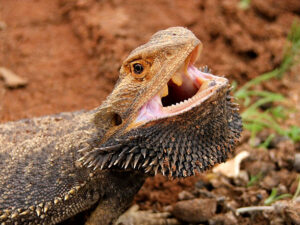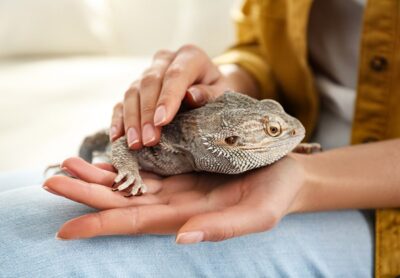Curiosity about the unique behaviors and preferences of our scaly companions often leads reptile enthusiasts to ponder one particular question: Do bearded dragons like to be petted? As we delve into the world of these fascinating creatures, it becomes apparent that their interactions with humans extend beyond mere observation.
Understanding the nuances of bearded dragon behavior, body language, and responses to touch unveils a deeper connection between these reptiles and their human companions. In this exploration, we aim to shed light on the often asked but intriguing query: do these scaled friends genuinely enjoy the gentle caress of a human hand? Let’s find out!
Do bearded dragons like to be petted?

Bearded dragons, like many reptiles, may not necessarily enjoy being petted in the same way that a mammal might. However, some bearded dragons do tolerate gentle handling and may even show signs of enjoyment. It’s essential to approach them calmly and slowly, allowing them to become accustomed to your presence.
When attempting to interact with a bearded dragon, start by gently stroking its back or head. Pay attention to its body language; if the dragon seems relaxed, it may be more receptive to handling. Avoid touching sensitive areas like the tail tip or toes, as these can be more delicate.
It’s crucial to respect the individual personality of each bearded dragon, as some may be more social and tolerant of handling, while others may prefer to be left alone. Always monitor their behavior and adjust your interactions accordingly. If a bearded dragon shows signs of stress, such as hissing, puffing up, or trying to escape, it’s best to give them some space.
Regular positive interactions, like hand-feeding and gentle handling, can help build trust and create a more positive association with human contact. Remember that each bearded dragon is unique, so observe their preferences and adjust your interactions accordingly.
Basic characteristics and behavior of bearded dragons
Bearded dragons (Pogona vitticeps) are popular pet reptiles known for their friendly demeanor and relatively easy care requirements. Here are some basic characteristics and behaviors of bearded dragons:
- Size and Appearance:
- Adult bearded dragons typically reach a length of 18 to 24 inches, with males often being larger than females.
- They have a flattened body covered in spiky scales and a distinct “beard” under their throat, which can puff up and turn black during certain displays.
- Lifespan:
- With proper care, bearded dragons can live 10-15 years or even longer.
- Habitat:
- Bearded dragons are native to the arid regions of Australia, so they require a habitat that mimics these conditions.
- A proper enclosure should include a basking area with a heat source, a UVB light source, a cooler area, and a substrate that allows for burrowing.
- Diet:
- Bearded dragons are omnivores. They eat a mix of insects (crickets, mealworms, dubia roaches) and a variety of vegetables and fruits.
- It’s important to provide a balanced diet with the right calcium and vitamin supplements.
- Behavior:
- Bearded dragons are generally known for their docile and calm nature. Many individuals tolerate handling well.
- They may exhibit territorial behavior, especially males. This can include head bobbing, arm-waving, and displaying their “beard” to establish dominance.
- Bearded dragons are diurnal, meaning they are most active during the day.
- Hibernation:
- In the wild, bearded dragons may experience periods of brumation (a form of hibernation) during cooler months. This behavior is not as pronounced in captive conditions, but some individuals may show reduced activity during the winter.
- Social Behavior:
- While bearded dragons are generally solitary, they can be housed together under the right conditions. However, introducing two males or a male and female without proper supervision can lead to territorial conflicts.
- Shedding:
- Like many reptiles, bearded dragons shed their skin as they grow. This is a normal process, and providing a humid hide in their enclosure can aid in shedding.
- Communication:
- Bearded dragons communicate through body language, including head bobbing, arm-waving, and changes in coloration. They may also make soft hissing sounds when stressed or threatened.
Understanding these basic characteristics and behaviors is crucial for providing proper care and ensuring the well-being of your bearded dragon. Regular veterinary check-ups and maintaining a suitable habitat are essential for their health and longevity.


